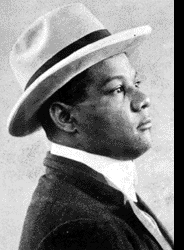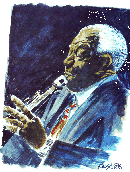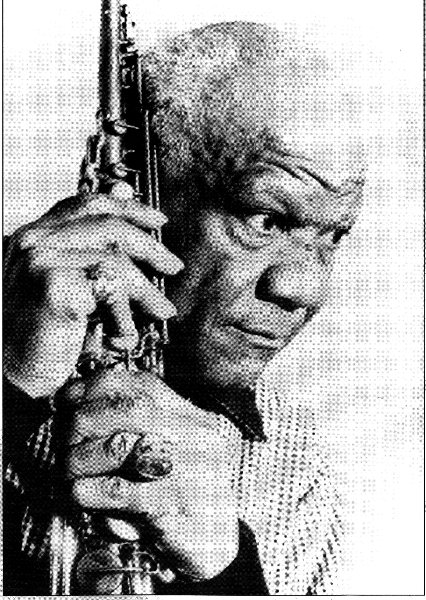 Sidney Bechet was a proponent of Dixieland Jazz who played the clarinet and was the first person to play Jazz on a Soprano Saxophone. Domineering is a word often used to describe his music. His various fights showed he had a short temper that shows in his music. His solo’s were often soaring and passionate, endlessly inventive, direct rather than ornate, and quite unmistakable. Early recordings show him as Louis Armstrong’s equal and, as he commands the ensemble with his burnished sound, his timing seems more in keeping with a trumpet lead than with the contrapuntal line usually adopted by saxophones and clarinets. Throughout his life, he never had the discipline needed to play in a regular band, he always preferred to be a soloist and worked in many different bands.
Sidney Bechet was a proponent of Dixieland Jazz who played the clarinet and was the first person to play Jazz on a Soprano Saxophone. Domineering is a word often used to describe his music. His various fights showed he had a short temper that shows in his music. His solo’s were often soaring and passionate, endlessly inventive, direct rather than ornate, and quite unmistakable. Early recordings show him as Louis Armstrong’s equal and, as he commands the ensemble with his burnished sound, his timing seems more in keeping with a trumpet lead than with the contrapuntal line usually adopted by saxophones and clarinets. Throughout his life, he never had the discipline needed to play in a regular band, he always preferred to be a soloist and worked in many different bands.
1897 Sidney Bechet was born on May 14, in New Orleans, Louisiana, into a "Creole" family. His father ran a shoe shop. All of Bechet’s brothers were keen musicians, but Sidney was the most talented.
1903 Without telling his family, he practiced secretly on his brother Leonard’s clarinet. During a family party he played along side Freddie Keppard. His playing was heard by George Baquet who was amazed by his promise and decided there and then to give him free lessons.
1908 At the age of just 11, he was hired by Bunk Johnson’s Eagle Band.
1910 His mother gave him permission to play in the Storyville clubs, provided that Bunk Johnson, who acted as a kind of guardian, brought him home each night.
1913 He started playing with King Oliver
1915 He made a tour of Texas in a band led by Clarence Williams.
1917 From clubs in Perdido Street in New Orleans he moved to Chicago, first with King Oliver and then Freddie Keppard. Later he left Keppard to play in other bands.
1919 With a band of Will Marion Cook he achieved great personal success in England, earning the admiration, among others, of the conductor Ernest Ansermet. When the band broke up he decided to stay in London with some other members of the band. He stayed there until, following a somewhat immoral adventure, he was hauled before the magistrates and expelled from the country. In addition to his love of traveling, Bechet was also well known for his love of the opposite sex, a fact that often got him into serious trouble.
Also while in London he brought a Soprano Saxophone, a more domineering instrument than the clarinet.
1921 He returned to the United States and got a job with the musical show "How Come?", in which the unknown Bessie Smith made her debut.
1923 He made his first recording with Clarence Williams in the Blue Five and also recorded with Louis Armstrong.
During this period he started to prefer the Soprano Saxophone to the Clarinet.
1924-25 In these years he worked with Mamie Smith, James P. Johnson and Duke Ellington’s Washingtonians. He also found time to manage a night club in Harlem the "Club Basha", but soon gotten tired of that. He also made his debut in Paris in a band led by Claude Hopkins, taking part in a show featuring Josephine Baker. When the show finally ended, in Berlin, Bechet once more indulged his love of traveling by taking part in a tour with Benny Peyton. He ended up in Russia and in Moscow he met Tommy Ladnier, who was also on tour. After this he toured all over Europe before finally going back to Harlem.
1929 He returned to Paris where after an episode of violence in which 3 people were wounded he was sentenced to 11 months in jail and expelled from France.
1928-31 Bechet continued to move back and forth between Europe and the United States. He went to Berlin and (clandestinely) to Paris with Noble Sissle’s band, then to New York and then back to Berlin. He also made a brief appearance with Duke Ellington’s orchestra, just enough to influence the style of Johnny Hodges.
1932 He formed "The New Orleans Feetwarmers" with Tommy Ladnier and recorded some real "gems".
1933 At the end of the year he suddenly decided to give up music to open , in partnership with Tommy Ladnier, a shop for mending and ironing clothes, which they called the "Southern Tailor Shop".
1934 Tired of his business life, Bechet again joined Noble Sissle’s band and made some excellent recordings.
1938 He left Sissle and free-lanced for a while. He took part in the "Panassie Session" with Tommy Ladnier and Milton "Mezz" Mezzrow.
1939 He made a superb recording of "Summertime" with Meade "Lux" Lewis and Teddy Bunn. He also recorded with Jelly Roll Morton.
 1940 An extremely important year. He recorded four masterpieces with Louis Armstrong, including "Perdido Street Blues". He also made some excellent recordings with a group known as the "Bechet-Spanier Big Four". He also recorded again with the "New Orleans Feetwarmers", reformed as a studio band. One result was the magnificent "Blues In Thirds" with Bechet on Clarinet and Earl Hines on Piano.
1940 An extremely important year. He recorded four masterpieces with Louis Armstrong, including "Perdido Street Blues". He also made some excellent recordings with a group known as the "Bechet-Spanier Big Four". He also recorded again with the "New Orleans Feetwarmers", reformed as a studio band. One result was the magnificent "Blues In Thirds" with Bechet on Clarinet and Earl Hines on Piano.
1944-48 During these year’s Bechet used many jazz soloists in his recording sessions: Sidney De Paris, Vic Dickson, Art Hodes, Pops Foster, Max Kaminsky, Albert Nicholas and others. He recorded a series of numbers with Mezz Mezzrow. In 1946 he had an idea of setting up a music school in Brooklyn; his most important pupil was Bob Wilber who recorded with him on several occasions. In 1947 he was a guest on several editions of Rudy Blesh’s radio show "This Is Jazz". In 1948 he played at the Jazz LTD in Chicago.
1949 He took part in the Paris Jazz Festival, organized by Charles Delauney, with triumphant success. The French finally forgot about the sad episode of 1929.
1950-54 Apart from some brief visits to the United States, Bechet lived and worked in Paris; he was literally adored by the French who knew him affectionately as "Le Dieu". His music was praised by Jean Paul Sartre’s existentialists, along with that of Juliette Greco. Bechet played mostly with the traditional bands of Claude Luter and André Reweillotty. In 1952 is song "Petite Fleur" became a world wide hit, and in 1953 his ballet score "La Nuit Est Une Sorciere" premiered in Paris.
1955 Bechet settled in Paris for good.
1957 He recorded an album with Martial Solal, Pierre Michelot and Kenny Clarke, entitled "When a Soprano meets a Piano".
1959 Sidney Bechet died on his sixty-second birthday, May 14. He had 3 wives over his life and kept a mistress to which he had a son to till he died.
The inhabitants of Jean-Les-Pins erected a monument in his honour.

Bechet was the very epitome of Jazz…
Everything he played in his whole life was completely original.
I honestly think he was the most unique man ever to be in this music.
……..Duke Ellington
Best Known Recording’s of Sidney Bechet
The Legendary Sidney Bechet
includes early "Feetwarmers" and "Blues In Thirds"
Sidney Bechet In New York
includes reunion with Louis Armstrong
The King Jazz Story Vol.4
Storyville, Best of Bechet-Mezzrows
Jazz Classics Vol.1
includes Bunk Johnson, Albert Nicholas
This page was updated on 29th April 1998
© 1997 kimberleyscott@hotmail.com
 Sidney Bechet was a proponent of Dixieland Jazz who played the clarinet and was the first person to play Jazz on a Soprano Saxophone. Domineering is a word often used to describe his music. His various fights showed he had a short temper that shows in his music. His solo’s were often soaring and passionate, endlessly inventive, direct rather than ornate, and quite unmistakable. Early recordings show him as Louis Armstrong’s equal and, as he commands the ensemble with his burnished sound, his timing seems more in keeping with a trumpet lead than with the contrapuntal line usually adopted by saxophones and clarinets. Throughout his life, he never had the discipline needed to play in a regular band, he always preferred to be a soloist and worked in many different bands.
Sidney Bechet was a proponent of Dixieland Jazz who played the clarinet and was the first person to play Jazz on a Soprano Saxophone. Domineering is a word often used to describe his music. His various fights showed he had a short temper that shows in his music. His solo’s were often soaring and passionate, endlessly inventive, direct rather than ornate, and quite unmistakable. Early recordings show him as Louis Armstrong’s equal and, as he commands the ensemble with his burnished sound, his timing seems more in keeping with a trumpet lead than with the contrapuntal line usually adopted by saxophones and clarinets. Throughout his life, he never had the discipline needed to play in a regular band, he always preferred to be a soloist and worked in many different bands. 1940 An extremely important year. He recorded four masterpieces with Louis Armstrong, including "Perdido Street Blues". He also made some excellent recordings with a group known as the "Bechet-Spanier Big Four". He also recorded again with the "New Orleans Feetwarmers", reformed as a studio band. One result was the magnificent "Blues In Thirds" with Bechet on Clarinet and Earl Hines on Piano.
1940 An extremely important year. He recorded four masterpieces with Louis Armstrong, including "Perdido Street Blues". He also made some excellent recordings with a group known as the "Bechet-Spanier Big Four". He also recorded again with the "New Orleans Feetwarmers", reformed as a studio band. One result was the magnificent "Blues In Thirds" with Bechet on Clarinet and Earl Hines on Piano.